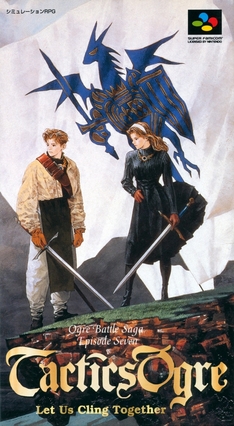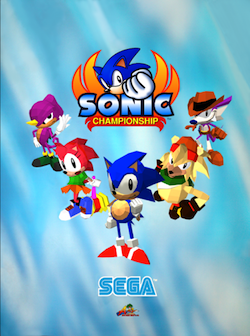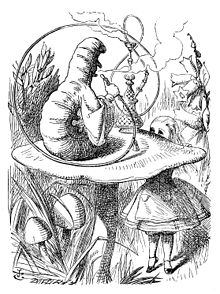
Tactics Ogre: Let Us Cling Together is a 1995 tactical role-playing game developed and published by Quest Corporation for the Super Famicom. It was later ported to the Sega Saturn (1996) and the PlayStation (1997), the latter released in North America in 1998 by Atlus USA. The second entry in the Ogre Battle series, the story takes place in the war-torn kingdom of Valeria, where protagonist Denim Powell works in a local resistance force against occupying powers, ending up caught in the ethnic conflicts driving the war. Battles are turn-based, taking place on grid-based maps from an overhead perspective with a focus on positioning and using character class abilities.

Sonic the Fighters, also known as Sonic Championship on arcade versions outside Japan, is a fighting game developed by Sega AM2. First released in 1996 in arcades on Sega's Model 2 arcade system, Sonic the Fighters pits players in one-on-one battles with a roster of characters from the Sonic the Hedgehog series.
Hack and slash, also known as hack and slay or slash 'em up, refers to a type of gameplay that emphasizes combat with melee-based weapons. They may also feature projectile-based weapons as well as secondary weapons. It is a sub-genre of beat 'em up games, which focuses on melee combat, usually with swords. Third-person hack and slash games are also sometimes known as character action games and spectacle fighters.

Virtua Fighter 2 is a 1994 fighting video game developed by Sega. It is the sequel to Virtua Fighter (1993), and the second game in the Virtua Fighter series. It was created by Sega's Yu Suzuki-headed AM2 and was released for arcades in 1994. Ports were released for the Sega Saturn in 1995 and Microsoft Windows in 1997.
A beat 'em up is a video game genre featuring hand-to-hand combat against a large number of opponents. Traditional beat 'em ups take place in scrolling, two-dimensional (2D) levels, while a number of modern games feature more open three-dimensional (3D) environments with yet larger numbers of enemies. The gameplay tends to follow arcade genre conventions, such as being simple to learn but difficult to master, and the combat system tends to be more highly developed than other side-scrolling action games. Two-player cooperative gameplay and multiple player characters are also hallmarks of the genre. Most of these games take place in urban settings and feature crime-fighting and revenge-based plots, though some games may employ historical, science fiction or fantasy themes.

Fantasy Earth Zero was a 2006 massively multiplayer online role-playing game developed for Microsoft Windows. Originally developed by Puraguru and Multiterm under the title Fantasy Earth: The Ring of Dominion, it was released by Square Enix as a paid product through its PlayOnline service. It relaunched under Gamepot as a free game, and was later handled by developers SoftGear and Ocean Frontier and was transferred back to Square Enix. Under the premise of a world where rival kingdoms engage in frequent conflicts, players choose an allied kingdom and fight against each other in groups of up to fifty players. The game closed down in September 2022.

Yggdra Union: We'll Never Fight Alone is a tactical role-playing game for the Game Boy Advance and PlayStation Portable, developed by Sting Entertainment as the second episode of the Dept. Heaven saga of games. Atlus USA localized and published both versions of the game in North America. 505 Games published the Game Boy Advance version in a limited number of European countries, such as Italy and France. A Nintendo DS side-game was released in Japan on December 3, 2009, as Yggdra Unison: Seiken Buyuuden. An updated version with bonus features was released in Japan for mobile platforms and Nintendo Switch in April 2019 and March 2020, respectively. A Windows version was released in early access on February 6, 2023, with a full release following on July 27, 2023, alongside a western release for Nintendo Switch.

Shin Megami Tensei: Devil Summoner is a role-playing video game developed and published by Atlus. Forming part of the Megami Tensei franchise, it is the first title in the Devil Summoner series. It was first released for the Sega Saturn in December 1995, and received a port to the PlayStation Portable in December 2005. Despite reports of it being planned for localization, neither version has been released outside Japan.

GrimGrimoire is a 2007 real-time strategy video game developed by Vanillaware and published by Nippon Ichi Software and Koei (Europe) for the PlayStation 2. The story follows Lillet Blan, a trainee witch who is sent into a repeating cycle of five days after her school is attacked by an evil wizard seeking the hidden Philosopher's Stone. The player commands units called familiars, each having strengths and weaknesses against the other, with the goal of either destroying the opponent's bases or surviving waves of enemies.

Odin Sphere is an action role-playing game developed by Vanillaware for the PlayStation 2. It was published by Atlus in 2007, and by Square Enix (Europe) in 2008. A remake, titled Odin Sphere Leifthrasir, was released on PlayStation 3, PlayStation 4, and PlayStation Vita in 2016: Atlus handled publishing duties in Japan and North America, while NIS America published the title in PAL territories.
Vanillaware Ltd. is a Japanese video game developer based in Osaka. An independent company, it was founded in 2002 under the name Puraguru by George Kamitani, a game developer who had previously worked at Capcom and Atlus, and directed Princess Crown (1997) for the Sega Saturn. Beginning as a small studio developing Fantasy Earth: The Ring of Dominion for Enix, in 2004 the company moved to Osaka, Kansai, and changed its name. Kamitani wanted Vanillaware to create successor projects to Princess Crown, beginning with Odin Sphere.

Baroque is a roguelike role-playing video game developed by Sting Entertainment. It was originally released for the Sega Saturn in 1998 by Entertainment Software Publishing, then ported to the PlayStation the following year. A remake for PlayStation 2 and Wii was released in Japan by Sting Entertainment in 2007, and later overseas in 2008 from Atlus USA and Rising Star Games (Europe). This version was later released on iOS in 2012, and an enhanced port of the original version on Nintendo Switch in 2020.

Devil Summoner, initially marketed as Shin Megami Tensei: Devil Summoner, is a video game franchise developed and primarily published by Atlus. Focused on a series of role-playing video games, Devil Summoner is a spin-off from Atlus' Megami Tensei franchise. The first entry in the series, Shin Megami Tensei: Devil Summoner, was released in 1995 for the Sega Saturn. The series has seen several more games since, with the most recent main entry being Soul Hackers 2 released in 2022.

Muramasa: The Demon Blade, known in Japan as Oboro Muramasa, is an action role-playing game developed by Vanillaware for the Wii, and later the PlayStation Vita. The game was published in 2009 by Marvelous Entertainment (Japan), Ignition Entertainment, and Rising Star Games (Europe). The Vita version was published in 2013 by Marvelous AQL in Japan and Aksys Games in Western territories. Using a 2D side-scrolling perspective, the gameplay revolves around a beat 'em up fighting system, while incorporating role-playing elements such as leveling and questing.

Dragon's Crown is a 2013 action role-playing game developed by Vanillaware for the PlayStation 3 and PlayStation Vita. It was published in Japan and North America by Atlus and in PAL regions by NIS America. A high-definition port for PlayStation 4, Dragon's Crown Pro, was released by Atlus in 2018. Players navigate environments from a side-scrolling perspective, choosing from six character classes to fight in the style of a beat 'em up and acquiring loot through repeated dungeon exploration. The storyline follows adventurers as they journey across Hydeland and become involved in the search for the magical Dragon's Crown.

Grand Knights History is a 2011 tactical role-playing video game developed by Vanillaware and published by Marvelous Entertainment for the PlayStation Portable. Following the adventures of a mercenary group in the employ of one of three warring nations, the player engages in turn-based combat while navigating maps. The game originally featured online competitive multiplayer where chosen teams of characters fight for their nation, but this ended when servers shut down in October 2013.

Code of Princess is an action role-playing video game developed by Studio Saizensen and originally published by Agatsuma Entertainment for Nintendo 3DS. It was released in Japan in April 2012 by Agatsuma Entertainment, and in North America by Atlus USA in October 2012, Agatsuma Entertainment also published the game in Europe and Australia in March 2013, exclusively as an eShop title. A version for Windows was released in April 2016. An enhanced port entitled Code of Princess EX launched for the Nintendo Switch between July and August 2018, courtesy of Nicalis worldwide, and Pikii in Japan.
Atlus West, formerly known as Atlus U.S.A., Inc., is the North American publishing branch of Japanese video game company Atlus, primarily known for localizing games for both them and other third-party developers. Its first original role-playing game was Revelations: Persona on the PlayStation, described by staff as an attempt to break into the Western role-playing game market and establish the company's Megami Tensei franchise through its Persona sub-series.

13 Sentinels: Aegis Rim is a 2019 video game developed by Vanillaware and published by Atlus. It was released for the PlayStation 4 in Japan in November 2019 and worldwide in September 2020, with a Nintendo Switch version released in April 2022. The game is divided between side-scrolling adventure segments and real-time strategy (RTS) battles, and follows thirteen high-school students in a fictionalized 1980s Japan who are dragged into a futuristic war between mechas and hostile Kaiju in a nonlinear narrative.

Unicorn Overlord is an upcoming tactical role-playing game developed by Vanillaware and published for Nintendo Switch, PlayStation 4, PlayStation 5, and Xbox Series X/S by Atlus in Japan and Sega worldwide. Set on the continent of Fevrith as it is consumed by war, the story follows exiled prince Alain as he gathers allies to take back his kingdom from the rogue General Valmore. Gameplay follows Alain and his army units fighting in large-scale battles, with field movement and battles taking place in real-time.


















